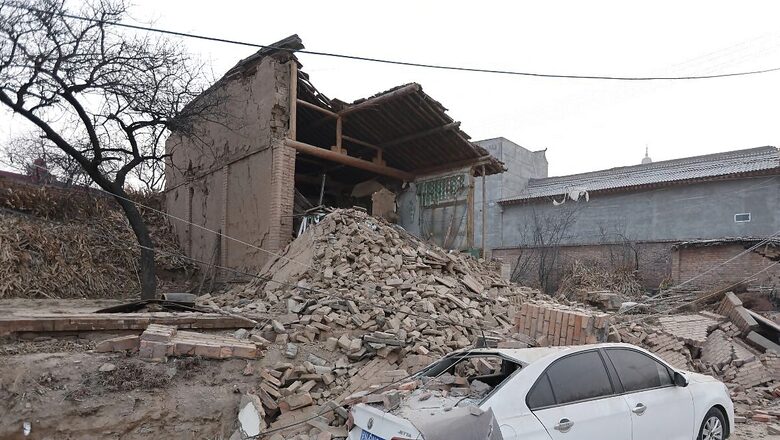
views
At least 127 people were killed and over 700 others injured when a powerful 6.2-magnitude earthquake jolted a mountainous region of northwestern China late Monday night, the deadliest quake in the quake-prone region in nine years. The quake, followed by strong aftershocks, killed 113 people in Gansu, while 14 died in the neighbouring Qinghai province in the Himalayan region, local authorities said on Tuesday as they launched rescue efforts in icy conditions.
Qinghai province is adjacent to the Tibet Himalayan region which is prone to frequent earthquakes due to shifting of continental plates. While 536 people were injured in Gansu, 182 people were wounded and 20 others missing in Qinghai, the state-run Xinhua news agency reported.
According to the China Earthquake Networks Centre, the shallow quake jolted Gansu and Qinghai provinces at 11:59 pm on Monday, with a focal depth of 10 kilometres. The epicentre of the earthquake Liugou township is about 8 km from the county seat of Jishishan Bao’an, Dongxiang, Sala autonomous county in Linxia Hui autonomous prefecture in Gansu.
The earthquake damaged 155,393 houses in Gansu. The epicentre of the earthquake in Gansu was only 5 km away from the boundary between the two provinces. Within 50 km of the epicentre, there are 22 townships in Qinghai, Xinhua reported.
Wang Wen, vice mayor of Haidong city in Qinghai, told the media that local departments will carry out safety checks on infrastructure like the supplies of power, water and gas, as well as communications to ensure that people’s basic necessities are met. Chinese President Xi Jinping and Premier Li Qiang have ordered all-out rescue efforts to minimise casualties after the earthquake.
Xi asked local authorities to rescue and treat the injured people promptly, and closely monitor the earthquake situation and weather changes to prevent secondary disasters. Monday night’s quake was China’s deadliest since an earthquake killed 617 people in Yunnan province in 2014.
Residents interviewed by Shanghai-based media outlet The Paper on Tuesday said many people were asleep when the quake struck and did not have time to take shelter. According to the Hong Kong-based South China Morning Post, a woman, who lives 90 km from the epicentre, said her house collapsed and she escaped being buried because she was still awake.
Videos and photos circulating on social media showed firefighting crews trying to pull out residents buried under rubble and others showed quake victims taking shelter on the road while wrapped in quilts amidst biting cold. The quake has destroyed some rural roads, leading to power outages and telecommunication failures. The maintenance crew has been working overnight to repair the damaged infrastructure.
Several villages suffered power failures and disruption of water. The Ministry of Transport, which monitors the operation of roads, said on Tuesday morning that a bridge across the Yellow River had cracked because of the quake.
According to local meteorological authorities, the daily low temperature in Jishishan is reported to climb minus 10 degrees Celsius on Tuesday. The provincial fire and rescue department sent 580 rescuers aided with 88 fire engines, 12 search and rescue dogs, and more than 10,000 sets of equipment to the disaster area.
The railway authority has suspended passenger and cargo trains passing through the quake zone and ordered a safety check of railway tracks. Meanwhile, a second quake struck the neighbouring Xinjiang Uygur Autonomous Region hours later on Tuesday.
The Atux City of Kizilsu Kirgiz Autonomous Prefecture in northwest China’s Xinjiang Uygur Autonomous Region, was struck by the earthquake at 9:46 am local time on Tuesday, the CENC said. The epicentre, with a depth of 10 km, was monitored at 40.02 degrees north latitude and 77.86 degrees east longitude, the CENC said.
Gansu and Qinghai also experienced aftershocks.




















Comments
0 comment